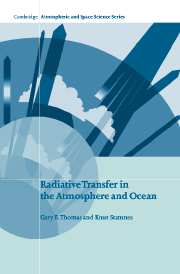Book contents
- Frontmatter
- Contents
- List of Illustrations
- Preface
- Acknowledgments
- Chapter 1 Basic Properties of Radiation, Atmospheres, and Oceans
- Chapter 2 Basic State Variables and the Radiative Transfer Equation
- Chapter 3 Basic Scattering Processes
- Chapter 4 Absorption by Solid, Aqueous, and Gaseous Media
- Chapter 5 Principles of Radiative Transfer
- Chapter 6 Formulation of Radiative Transfer Problems
- Chapter 7 Approximate Solutions of Prototype Problems
- Chapter 8 Accurate Numerical Solutions of Prototype Problems
- Chapter 9 Shortwave Radiative Transfer
- Chapter 10 Transmission in Spectrally Complex Media
- Chapter 11 Radiative Transfer in Nongray Media
- Chapter 12 The Role of Radiation in Climate
- Appendices
- Index
Chapter 10 - Transmission in Spectrally Complex Media
Published online by Cambridge University Press: 18 December 2009
- Frontmatter
- Contents
- List of Illustrations
- Preface
- Acknowledgments
- Chapter 1 Basic Properties of Radiation, Atmospheres, and Oceans
- Chapter 2 Basic State Variables and the Radiative Transfer Equation
- Chapter 3 Basic Scattering Processes
- Chapter 4 Absorption by Solid, Aqueous, and Gaseous Media
- Chapter 5 Principles of Radiative Transfer
- Chapter 6 Formulation of Radiative Transfer Problems
- Chapter 7 Approximate Solutions of Prototype Problems
- Chapter 8 Accurate Numerical Solutions of Prototype Problems
- Chapter 9 Shortwave Radiative Transfer
- Chapter 10 Transmission in Spectrally Complex Media
- Chapter 11 Radiative Transfer in Nongray Media
- Chapter 12 The Role of Radiation in Climate
- Appendices
- Index
Summary
Introduction
Having established some concepts of absorption and line-broadening processes in Chapters 3 and 4, we may now discuss more practical aspects of determining the transmission and radiative transfer within spectrally complex media. We first consider how radiation is transmitted through a medium characterized by absorption within a single, spectrally isolated line. This introduces the historically important quantity, the equivalent width. A generalization of this notion to include progressively more realistic absorption properties brings us to the various parameterizations of complex transmission processes, known as molecular band models. A large number of such models have been introduced over the years, all attempting to replace a very messy transmission problem with one or more analytic functions having a minimum number of parameters. These band parameters are derived from either comparisons with laboratory data or, since the advent of fast computers, with accurate line-by-line (LBL) computations. Since these classical methods are limited in accuracy, and cannot generally accommodate the simultaneous effects of scattering and absorption, it has been a goal in the field for many years to improve these descriptions. Many attempts have been made toward this end, and considerable progress has been made. Since many other references have covered band-model theory, we will provide only a few examples, before discussing the more modern methods, with emphasis on performing calculations for realistic inhomogeneous gaseous media.
There are two basic reasons why the absorption properties of a molecular gas depend very strongly upon wavenumber: (1) The line strengths can vary drastically over a given band, and (2) within a given line, the absorption coefficient changes many orders of magnitude over small wavenumber intervals.
- Type
- Chapter
- Information
- Radiative Transfer in the Atmosphere and Ocean , pp. 384 - 412Publisher: Cambridge University PressPrint publication year: 1999



